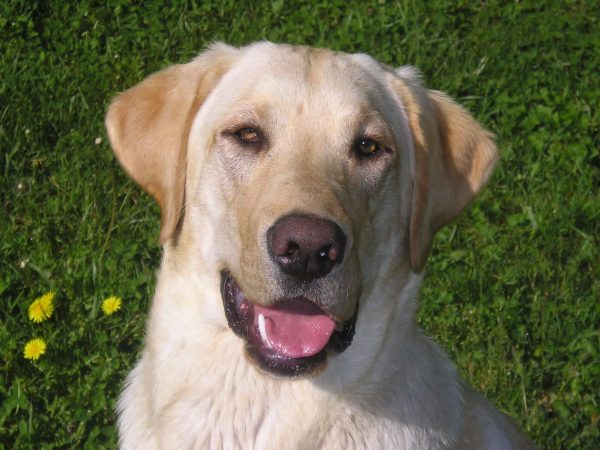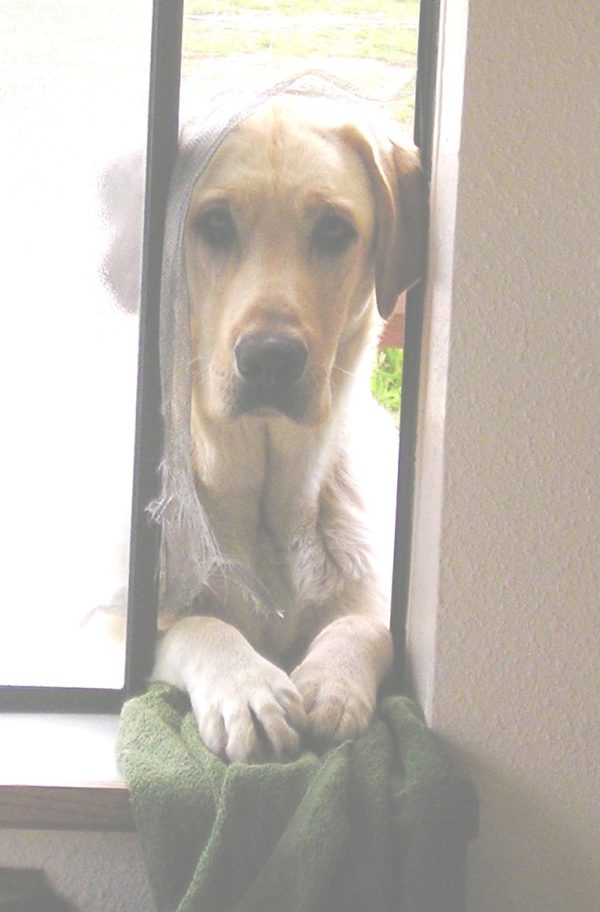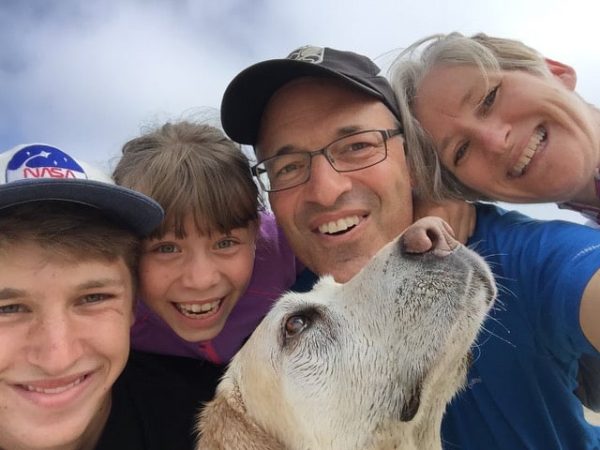What’s that racket? Who’s screaming? Is someone hurt? I asked these questions as I entered the shelter where I was volunteering. I couldn’t hear myself think let alone talk to the volunteer coordinator. She yelled, “Oh, that’s Kobe. He’s crazy. We picked him up from a high-kill shelter yesterday.” The poor dog had been adopted and returned four times already, just through that shelter.
I decided to go back and meet the dog who was making so much noise. There he was, a yellow blur, leaping to the top of the kennel and back down again — up and down, up and down. With each jump, Kobe screamed bloody murder. He was foaming at the mouth in severe anxiety, a frightened, reactive mess.

Kobe was happy to get out of the shelter. (Photo by Jill Breitner)
Kobe’s story is typical. He was purchased from an unethical, backyard breeder to be a family dog, but became too much to handle and was surrendered to a shelter at 9 months old. A responsible breeder would have asked the adopters what their lives were like, did they have any kids, what are their ages, and how often would the family be away from home. Such a breeder may have recommended against getting an 8-week-old puppy, as the family had young children and the dog would need to be crated for longer than emotionally healthy.
By the time I adopted Kobe from the high-kill shelter, he was just 1 year old and already had been in 10 homes. Because of this, he was suffering from psychological trauma. Living in a shelter environment was worsening his behavior, causing anxiety and extreme duress. His chances of becoming aggressive and biting someone were escalating, and euthanasia was getting more probable by the minute. I could not leave him there one more day.

Kobe thought this would be faster than coming through a door. (Photo by Jill Breitner)
It didn’t take long for Kobe to trust that I wouldn’t abandon him — because I didn’t. He would scream when I went into the horse pasture, even though I was in sight. That lasted 3 days. Yep, that’s all. Kobe quickly learned my routine, waiting by the gate patiently, and knew I would return. I didn’t do much with him those first few days, other than observe and allow him to settle into his new life with me and mine. The first days after an adoption should be about letting a dog adjust to a new environment, new friends (both people and animals), and creating a safe and secure place where they can begin to trust again.
Of course, Kobe did some really goofy things in our early days together, like the time I was in the pasture and he was starting to feel secure to explore on his own. When I returned, I found him standing on top of my refrigerator, where I keep doggie treats. There was also the time when he decided that it would be faster to come inside through the bathroom window than through the open door.
I soon discovered that Kobe loved learning. He also loved playing with my dogs, sleeping in my room, hiking, riding in the car, swimming in the river, and being part of our family. He never saw a dog run or a crate again. All his problems went away because all of his needs were being met with training, exercise, and tons of love — the real Kobe had emerged under my care. After nine months living in our home, friends of ours fell in love with him and gave him his forever home. He is an incredible dog who is still going strong at 12 years old.

Kobe today, 10 years later still with his forever family. (Photo by Jill Breitner)
Successfully bringing a puppy into your life requires many things. Factor your lifestyle and family situation into choosing the right type of dog. Know going in that training is a part of raising a puppy. Choose an ethical breeder or adopt. Be prepared for the new puppy. Find a positive reinforcement trainer to help you help raise your puppy into the best adult dog you could possibly imagine. If you don’t do all of these things, you may end up in the same situation Kobe’s original family found themselves.
About the author: Jill Breitner is a professional dog trainer and dog body language expert, loving and living life with friends and family. She a certified Fear Free Professional and the author of Dog Decoder, a smartphone app about dog body language. Join Jill on her Dog Decoder Facebook page.
The post How I Turned a Puppy Surrendered 10 Times Into a Great Family Dog appeared first on Dogster.
No comments:
Post a Comment